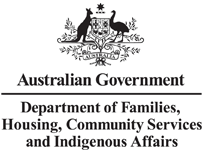Client: FaHCSIA
Services: Business analysis and project management advisory
Project value: $1.5M (initial build project)

Context
It’s a fundamental question in social policy: “where should government funds be allocated, and how will we know if our grant programs have worked?”
For FaHCSIA, answering this question was difficult because staff lacked timely access to reliable data. For example, a program officer could be designing a grant to service providers for parents of children with a disability. The officer needs data on the areas where these parents live, and which service providers are already located nearby.
In this scenario, the officer would submit a query to the data requests team, who’d respond with clarifying questions… the back and forth could take weeks to resolve.
Even when the policy officer received the final report, the provenance and reliability of the data wasn’t always clear: they didn’t know the data’s source, or how it was collected.
To manage grants programs more effectively, FaHCSIA knew they needed a better data solution.
Our role was to help deliver that solution: a set of self-service dashboards allowing users to interrogate a series of data marts. With this tool, any user could explore data themselves and generate the reports they needed in any instant. The underlying data warehouse would draw from databases across Departments:
- Centrelink’s Longitudinal Data Warehouse (LDW)
- FaHCSIA’s Online Funds Management System (FOFMS)
- FaHCSIA’s Grant Management System (GMS) and
- ABS Census Basics.
The model would be scalable and re-usable, reducing the cost of creating new dashboards and data marts.
To get there, though, we had some hurdles to clear.
Approach
As lead business analysts on this project, our first task was to capture stakeholder requirements. However, given the breadth of our stakeholder set, some people needed to be re-engaged. They needed to see the business benefits of the tailored self-service dashboards, and understand how it was relevant to their work. They also had to be confident that we had a path to achieving those benefits.
We set out to do this by:
- Collaborating with the Programs Operations Group to map key decision points in the grant management cycle.
- Demonstrating how the reporting and analysis dashboards could support grants management.
- Establishing relationships with stakeholders from groups including program areas and IT operations.
- Making sure our work meshed with interdependent projects and capabilities, including: FOFMS and GMS system development, the upstream ETL and data warehouse capability, and Centrelink LDW development.
Solving the problem of geography
Turning to the data itself, our biggest challenge was forming a complete view of activity by service provider or region. Here we ran into a basic problem of inconsistent identification.
FaHCSIA didn’t use a unique identifier for funded organisations (such as ABNs). Nor were address validation rules applied when new organisations were added to grant management systems, so it was very easy to accidentally enter invalid addresses.
As a result, FaHCSIA struggled to answer some essential questions. For example, a grants administrator had no easy way of understanding how much funding was allocated to all branches of the Salvation Army across all programs.
Our solution was to link up service provider data across systems via heuristic matches. Records from different programs and systems were classed as relating to the one service provider organisation where they met name resemblance and geographic proximity rules.
With accurate location data, a grants management officer could use the data mart’s dashboard to answer key questions:
- “What is the nett (layered) FaHCSIA program presence or spend in any community?”
- “What is FaHCSIAs grant spend with any particular service provider entity or group eg. Salvation Army?”
- What can we tell about the demographics of any specific target ‘community’? (what is its profile?)
Documenting the data
We then examined each field of data to confirm provenance: its source and currency. We transferred this data into the data mart via a structured ETL (extract, transfer, load) process. For quality assurance, we used Hyperion business intelligence capability: within seconds, we could detect any problems in the ETL process, and pinpoint exactly where the issue occurred, and what data was affected.
With this information, we could then document each dataset and make that documentation accessible via the reporting portal, so the end user knew where each data field originated and when it was last updated.
Result
Our work enabled FaHCSIA policy analysts and grant programs managers to explore data interactively that was both current and quality assured. By tracking the data supply from end to end, our work also drove major improvements in data capture. We established a strategic program of work to address systemic data quality issues, including the implementation of ‘validation at data entry’ functionality in source (grant management) systems.
With our help, the project’s scope and costings were clarified and business benefits realised. Evidence-based decision-making is supported. Thanks in part to our work, FaHCSIA is now the leading agency in best practice grants management. The dashboard, and the data remediation work behind it, demonstrate the value of getting both technology and data governance right.

